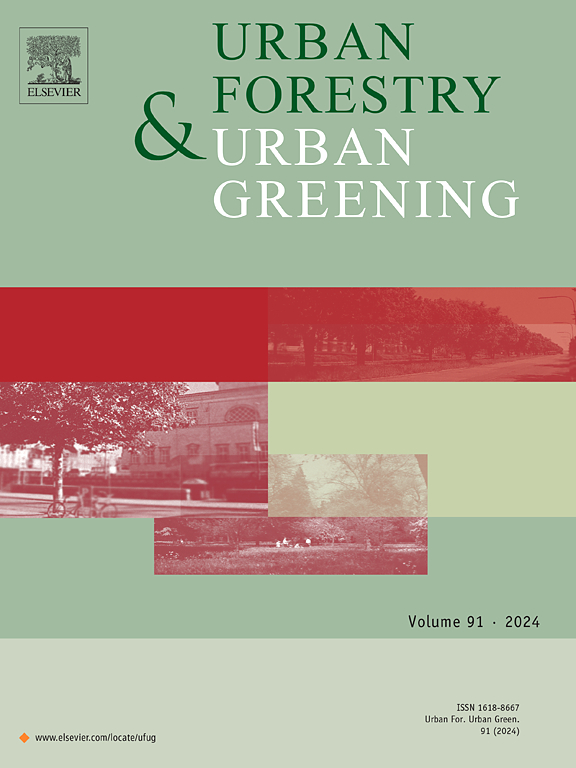Unravelling leaf hydraulic responses to urbanization and the coordination with economic strategies of subtropical urban forests
IF 6
2区 环境科学与生态学
Q1 ENVIRONMENTAL STUDIES
引用次数: 0
Abstract
Urban plants’ functional traits largely reflect their resilience to environmental stresses, necessitating a deeper understanding of plant adaptive strategies for sustainable urban forestry. This study investigated the intraspecific variation and coordination of leaf economic and hydraulic traits in eight subtropical tree species along an urbanization gradient in Hefei, China. We observed that trees in urban site exhibited enhanced drought tolerance traits compared with rural site, including more negative water potential at 50 % loss of hydraulic conductivity and turgor loss point, alongside higher leaf hydraulic conductance and leaf vein density. Urban trees also displayed lower leaf mass per area and higher leaf photosynthesis rate, indicative of an acquisitive resource strategy, contrasting with rural trees’ conservative traits (e.g., thicker palisade tissue). Principal component analysis demonstrated divergent trait coordination: urban trees prioritized hydraulic safety and photosynthetic efficiency, while rural trees emphasized structural investment. We also discovered that urbanization weakens the linkage between hydraulic and economic trait spectra in plant leaves, triggering a shift from the "coordinated optimization" adaptation mode observed in rural ecosystems to a "modular adaptation" strategy in urban to balance hydraulic safety and resource allocation demands. Collectively, our results revealed that the economic strategies of leaves showed a trend from conservation to acquisition along urbanization gradients extending from rural to urban sites. Our findings also reveal that urbanization progression leads to a weakening of the correlation between leaf hydraulic and economic traits in plants, providing a mechanistic understanding of how trees adapt to urbanization habitats.
亚热带城市森林叶片对城市化的水力响应及其与经济策略的协调
城市植物的功能性状在很大程度上反映了它们对环境胁迫的适应能力,需要对可持续城市林业的植物适应策略有更深入的了解。本文研究了合肥地区8种亚热带树种叶片经济性状和水力性状在城市化梯度下的种内变异和协调性。我们观察到,与农村地区相比,城市地区的树木表现出更强的耐旱性,包括在50% %的水力导度损失和膨胀损失点时更多的负水势,以及更高的叶片水力导度和叶脉密度。城市树木的单位面积叶质量较低,光合速率较高,与农村树木的保守性状(如栅栏组织较厚)形成鲜明对比,表明城市树木具有获取性资源策略。主成分分析表明,城市乔木优先考虑水力安全和光合效率,而农村乔木强调结构投资。我们还发现,城市化削弱了植物叶片中水力和经济性状谱之间的联系,促使农村生态系统从“协调优化”适应模式转向城市生态系统的“模块化适应”策略,以平衡水力安全和资源配置需求。总体而言,我们的研究结果表明,沿着城市化梯度,从农村到城市,叶片的经济策略呈现出从保护到获取的趋势。我们的研究结果还表明,城市化进程导致植物叶片水力和经济性状之间的相关性减弱,为树木如何适应城市化栖息地提供了机制理解。
本文章由计算机程序翻译,如有差异,请以英文原文为准。
求助全文
约1分钟内获得全文
求助全文
来源期刊

Urban Forestry & Urban Greening
FORESTRY-
CiteScore
11.70
自引率
12.50%
发文量
289
审稿时长
70 days
期刊介绍:
Urban Forestry and Urban Greening is a refereed, international journal aimed at presenting high-quality research with urban and peri-urban woody and non-woody vegetation and its use, planning, design, establishment and management as its main topics. Urban Forestry and Urban Greening concentrates on all tree-dominated (as joint together in the urban forest) as well as other green resources in and around urban areas, such as woodlands, public and private urban parks and gardens, urban nature areas, street tree and square plantations, botanical gardens and cemeteries.
The journal welcomes basic and applied research papers, as well as review papers and short communications. Contributions should focus on one or more of the following aspects:
-Form and functions of urban forests and other vegetation, including aspects of urban ecology.
-Policy-making, planning and design related to urban forests and other vegetation.
-Selection and establishment of tree resources and other vegetation for urban environments.
-Management of urban forests and other vegetation.
Original contributions of a high academic standard are invited from a wide range of disciplines and fields, including forestry, biology, horticulture, arboriculture, landscape ecology, pathology, soil science, hydrology, landscape architecture, landscape planning, urban planning and design, economics, sociology, environmental psychology, public health, and education.
 求助内容:
求助内容: 应助结果提醒方式:
应助结果提醒方式:


